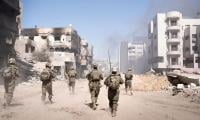Pakistan’s socio-economic landscape is shockingly divided. Eastern Pakistan, comprising Punjab and Sindh, is more developed, with a higher rate of literacy and quality education, 99 percent of Pakistan’s industrial base, access to water for irrigation, advanced rate of employment and a modern health system. And now it also has a larger share of CPEC investment.
Fata, Balochistan and Khyber Pakhtunkhwa, on the other hand, fall on the western side of Pakistan. These areas have over 80 percent poverty, a crumbling infrastructure, decaying education and health systems, high levels of unemployment, zero industrialisation and high levels of physical insecurity. They also have a very small share in CPEC investment.
The underdevelopment of the western part of Pakistan and over-development of the eastern part of country is not mere imagination. Pakistan’s first ever Multidimensional Poverty Index (MPI), launched in June 2016, highlighted these stark socio-economic variances in. Punjab’s central and northern districts have less than 10 percent poverty while Balochistan and Fata show an alarming 70 percent multidimensional poverty.
The MPI further confirmed that progress across different regions of the country is uneven. Disparities also exist across the provinces. For example, the report states that over two-thirds of the people in Fata (73 percent) and Balochistan (71 percent) live in multidimensional poverty. Poverty in Khyber Pakhtunkhwa stands at 49 percent, Gilgit-Baltistan and Sindh at 43 percent, Punjab at 31 percent and Azad Jammu and Kashmir at 25 percent.
Such an uneven socio-economic divide didn’t just emerge overnight. It is the result of persistent policies and a lack of transparency and democratic values. The faulty federal structure has always created incentives, initiatives and opportunities for certain regions and groups and discriminated against those who have little or no say in the system.
When the CPEC opportunity arrived it was branded as a ‘game changer’ which would turn Balochistan into Pakistan’s ‘economic tiger’ and Pakistan into an ‘Asian tiger’.
However, to many people the CPEC project seems to have technically concentrated towards the highly developed eastern parts of Pakistan – thus depriving the western parts of the energy, road and rail projects that are the basic elements of long-term development. This kind of over-concentration of CPEC and national development projects in better developed regions is going to widen the alarming socio-economic gap between the country’s eastern and western parts.
Once completed and operationalised, CPEC’s energy and infrastructure projects could end up shifting the balance of political, social, and economic power to the two main provinces, leaving behind Balochistan, Fata and KP in a vicious cycle of multidimensional poverty.
Energy is the dominant component in CPEC projects. Around $22 billion out of CPEC’s $47 billion is in the energy sector. That includes coal, wind, thermal and hydel power projects including transmission lines, which are expected to generate and transmit over 10,000 MW of electricity to Punjab and Sindh.
Out of 15 CPEC energy priority projects, 14 projects are located in the eastern part of Pakistan (seven in northern and central Punjab and seven in Sindh); in the west, KP has only one project. Balochistan, KP and Fata will not benefit from any energy project or transmission line that is going to be produced in Punjab or Sindh.
It is, thus, not difficult to conclude that CPEC-generated energy will not provide any relief to power-sector consumers in Balochistan and Fata. Simply, there is no electricity infrastructure project to transmit power to Pakistan’s downtrodden and energy-starved regions.
Under CPEC’s energy component, there are two transmission lines worth $4 billion. Both transmission lines crisscross Sindh and Punjab and will run from Matiari to Lahore and Matiari to Faisalabad, transmitting close to 4,000 MW of electricity to central and northern Punjab.
Like road and other poor infrastructure, the existing energy related infrastructure such as transmission and distribution networks in KP, Balochistan and Fata are outdated, faulty and inadequate. Even if surplus electricity from CPEC’s energy projects were to be offered to these areas, they do not have enough capacity or system to absorb energy beyond 500MW.
Currently, out of the 5,110km of the National Transmission and Dispatch Company’s 500KV transmission line, Balochistan only has a 27-kilometre circuit length. The current power demand in Balochistan is around 1,650MW. But it is being supplied between 400MW and 600MW, resulting in massive electricity shortages. Persistent loadshedding of between 12 to 18 hours in major towns, excluding Quetta, is a matter of routine regardless of the season.
These underdeveloped and neglected areas of the country are facing a major power shortage. Over 45 percent of the population has no access to electricity. In contrast, the availability of electricity for industrialisation and commercial use in provinces such as Punjab and Sindh generates employment and revenue in those areas.
Minister for Power Khawaja Asif also said in a TV talk show on February 2, 2017 that regions like Balochistan and Fata will not benefit from energy produced under the CPEC energy projects due to poor recovery in these areas.
The second largest component in CPEC’s projects is infastructure. Infrastructure projects constitute about $14 billion out of the total $47 billion CPEC investment. All five major infrastructure projects – KKH Phase II (Thakot-Havelian Section), (Multan-Sukkur Section), expansion and reconstruction of existing Line ML-1, Lahore Orange Metro – are sprinkled in Punjab and Sindh.
Projects in these eastern regions, Punjab and Sindh, will have a strong impact on the economy and on social development. For example, only the 27 kilometer-long Lahore Orange Line Metro will initially benefit around 250,000 passengers every day – which will be increased to 500,000 passengers by 2025. The Metro Line increases mobility, accessibility, efficiency and productivity. It has already generated more than 15,000 direct and indirect jobs and provided an impetus to central Punjab’s small and medium enterprises.
CPEC is a game-changer and will affect economic growth, employment and social development in the targeted regions. However, due to poor planning, designing and over-concentration of CPEC projects in these areas there will hardly be any socio-economic impact on the conflict-stricken, poverty-hit and marginalised regions of the country.
The much-talked about Gwadar Port will have little impact on the province’s crumbling socio-economic landscape. Based on current constitutional arrangements, revenue generated from the port and the Gwadar airport will be collected by the federal government, not by the provincial government.
In addition, the security architecture could have been a great source of employment for the Baloch but has already been taken over by the federal government. Initiatives such as the Special Security Division (SSD) project, the Gwadar Security Task Force and the navy’s special ‘Task Force-88’ (TF-88) have provided no employment and participation opportunity to locals in the province.
Under CPEC, we could have created stakes in the system for the people of Balochistan by raising a representative force recruited from relevant districts of the province. Unfortunately, that did not happen.
People in Pakistan’s poverty-hit provinces and regions live in a different world, and their fate and future is shaped by security-centric strategies and priorities. Insecurity has been used as an excuse to justify poverty and underdevelopment in Balochistan and Fata. But no peaceful solution has been proposed by any institution to address the prolonged conflicts triggered by socio-economic inequalities and discrimination.
Such discrimination has also created a divided society in a wounded landscape where millions live on empty stomachs. The division is growing but the gap is being filled through oppressive means rather than sustainable policies.
The writer is a former senator from Balochistan.
Email: balochbnp@gmail.com
A representational image showing stacks of Rs5,000 and Rs1,000 notes. — AFP/FileOnce again there is debate...
A representational image showing late Pakistani human rights activist and Supreme Court lawyer Asma Jahangir. —...
A representational image showing a security personnel sanding guard beside a ship carrying containers at Gwadar port....
A health worker administers polio vaccine drops to a child during a door-to-door polio vaccination campaign in Lahore,...
Armed militants of the banned Tehreek-e-Taliban Pakistan pose for a photograph in Orakzai Agency. —...
An aeroplane of the national flag carrier of Pakistan is seen in this file photo. — AFPWhile Pakistan considers...







